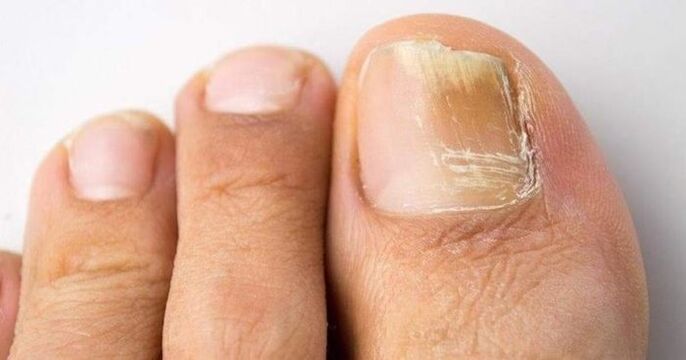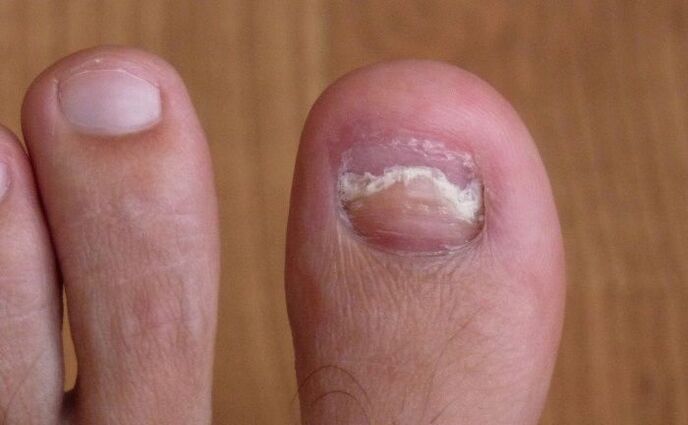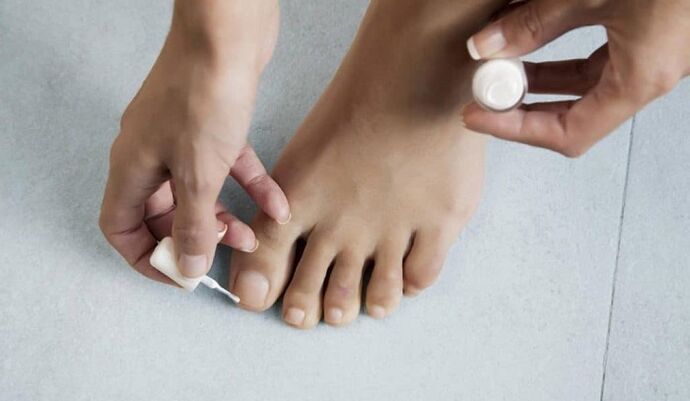Fungal diseases can affect various tissues in the body, even internal organs. If the disease has affected the nail, it is called onychomycosis. Its appearance is caused by fungal microorganisms.
They are subdivided into different genera: candida, moldy fungi, dermatophytes. The parasites literally feed on the nail plate, which leads to its early destruction. The yeast infection itself does not go away. This is possible only with the strongest work of the immune system and the first stage of the disease, when the symptoms are not visible. If signs of illness appear, you can be sure they won't go anywhere without therapy.

Reasons for the appearance
Fungal microorganisms belong to the class of irritants. They are extremely stubborn. They quickly penetrate into the tissues, adapt to various conditions. This is due to the complexity of the treatment of the disease. If you use the same medicine for a long time, the parasites may stop responding to it.
The only reason for the appearance of the disease is the penetration of fungi on the nail plate. However, there are factors that favor its early introduction inside and subsequent reproduction. Microorganisms are more likely to enter tissue if they have corns. Even dry skin can lead to microcracks, through which fungi can easily penetrate. The microorganism "likes" humid conditions and therefore actively propagates in people who prefer tight shoes made of poor materials that do not pass air.
Often the fungus of the nail of the big toe occurs against the background of various pathologies:
- Endocrine diseases;
- Psoriasis;
- Varicose veins;
- Vascular diseases;
- HIV and AIDS;
- Problems with metabolic processes;
- Eczema;
- Dermatitis;
- Cutaneous infectious process.
Fungal microorganisms can enter plaque in the following ways:
- Contact with a carrier of infection;
- Visit of public baths, saunas, showers;
- Put on other people's slippers (for example, at a party);
- Living with a person with yeast infection;
- Trying on shoes;
- Use pedicure tools that have not been disinfected;
- Visit beauty salons.
The factors that provoke the appearance of yeast infections are also:
- Lack of adequate personal hygiene;
- Preference for synthetic items;
- Wear tight shoes that do not allow the skin to "breathe";
- Excessive obesity;
- Frequent alcohol consumption;
- Advanced age.
The disease will have more striking manifestations if a person has circulatory disorders in the feet. In addition, a change in the acid balance observed when taking antibiotics can lead to pathological processes.
Stages of the disease
The surface under the nails is very favorable for the growth of fungal microorganisms. It contains many nutrients that parasites feed on. Gradually, due to the effects of bacteria, the destruction of the nail plate occurs. Voids begin to form, in which the mycelium of the fungus multiplies. There are the following stages of the disease:
- Initial.Refers to the type of normotrophic damage. The main damage affects the center or the edge of the plate. Spots and stripes appear, which gradually begin to develop;
- Way.Represents hypertrophic changes. This stage is characterized by thickening of the nail, a change in its structure, the direction of growth. Pathological processes gradually spread throughout the plaque;
- Stage of dystrophy.To the listed processes, inflammation in the area of the nail fold is added. A discharge of pus is possible. The lesion affects the neighboring skin. Additional bacterial infections accelerate the destruction of the nail. It begins to crumble, it may flake off the nail bed.
At the very beginning, the symptoms are insignificant, and as a result, people often take the disease lightly. However, he is progressing rapidly. Very soon, the spots that have appeared will begin to develop. The disease can spread from the thumb to others.
If only the sticker is affected, it is usually mild to moderate. Therapy should be done immediately.

Symptoms
Symptoms vary widely depending on the stage of the disease. At the very beginning, the signs of a threat are almost impossible to notice. With the development of the disease, the following symptoms can be observed:
- Slight itching;
- Redness in the thumb area;
- Burning sensation.
But the pathological process does not stop. Its growth can be judged by the following characteristics:
- Brittle plate, loss of natural shine;
- Acquisition of a yellow, blue or green tint (depending on the type of fungal microorganisms that have affected the nail);
- Pronounced spots and stripes appear;
- The nail grows with its corners into the roll, which testifies to the deformation of its growth.
At an advanced stage, the following symptoms are likely:
- Pain syndrome when walking;
- The appearance of swelling of the finger, its significant redness;
- Discharge of pus under the edges.
The signs of big nail fungus can vary depending on the type of fungus that is causing the infection. For example, if it is moldy mushrooms, the disease will be very pronounced. The nail can literally turn black. There is swelling, the appearance of silvery scales, yellow edges. The plaque begins to move away from the bed, causing severe discomfort. However, in 95% of cases, the cause of infection is dermatophytes. They are characterized by a relatively moderate course of the disease.
The disease affects not only the nail, but the whole body. This is due to the fact that the toxins enter the lymphatic channels. This causes the following changes:
- Allergic reactions, the appearance of rashes;
- Gastrointestinal problems;
- Signs of intoxication.
If left unchecked with the advanced stage of the yeast infection, the lesion can spread to internal organs. It is extremely dangerous.
How's the treatment going?
How to cure nail fungus? Pathogenic microorganisms are distinguished by enviable resistance to various influences. They quickly take root indoors and begin to actively multiply. Therefore, it is desirable to carry out full-fledged antifungal therapy. He understands:
- Use of local funds. It can be ointments, drops, medicated varnish, solutions. They are necessary for overcoming the disease on a superficial level. Local remedies include varnish, serum;
- Systemic drugs. They are used for large lesions of the nail plate. The tablets are used daily. Pulse therapy is effective. It consists of taking short-term medication with a long break. Then the course is repeated. It should be borne in mind that the pills cannot be taken in all cases. Do not use them at the initial stage of the disease. These funds are quite powerful and therefore have contraindications: pregnancy, childhood, renal failure, intolerance to components.
The disease is often accompanied by bacterial complications. You can also be safe from them. The antifungal varnish is perfect for this purpose. It creates a film on the surface of the plaque through which bacteria do not enter.
In addition, it is necessary to stimulate the defensive goals of the body, which will be oriented towards the fight against infection. For this, vitamin complexes, immunomodulatory drugs are used.
Most drugs have a cumulative effect. It is not enough to take them once and forget about therapy. Full course required.
It doesn't stop even if all the symptoms are gone. The active substances accumulate in the integument and continue to act even after the end of the medication.
Another additional procedure is nail removal. Relevant for strong pathological processes. Removal can be carried out using special products containing urea. If the plate is rigid, several procedures will be necessary to remove it completely. Withdrawal should not be feared, as it is painless. After removal, you need to treat the surface with antiseptics. Removal is convenient, because after that local remedies can be applied directly to the nail bed. This greatly improves their efficiency.

Traditional methods
Folk remedies cannot replace drugs. But they are suitable for additional help. The following components help the fungus:
- Iodine.The affected area should be lubricated with iodine twice a day. If there is a burning sensation, you need to remove any excess and reduce the dose;
- Lemon.A lemon slice is applied to the affected area, after which it is fixed with a bandage. The cellophane is placed on top;
- Hydrogen peroxide.A cotton ball is moistened in hydrogen peroxide, after which it is fixed on the nail for 30 minutes. Softened areas can be removed.
After all of these procedures, treatment with topical antimicrobial agents is desirable.
Preventive measures
It is important to observe preventive measures not only for a person who does not want to get infected with yeast infection. They are fundamental for people who have just got rid of the disease. Prevention consists of the following rules:
- Respect for personal hygiene;
- Daily foot bath;
- Lubrication of the feet with moisturizers, pedicure;
- Use of personal slippers;
- Treatment of nails with prophylactic agents before visiting baths, showers. You can replace the special product with lemon juice.
The prevention measures for people who have recently had a yeast infection are even stricter:
- Use a local remedy for fungus once a week;
- Regular use of hot foot baths with the addition of sea salt;
- Treatment of shoes with antifungal compounds;
- Boiling socks, in which there is a complete destruction of microorganisms;
- You must continue to take vitamins;
- The surface of the bath is disinfected. It is advisable to treat all other surfaces in the house as well.
Prevention with a high degree of probability protects against fungal infection. You just need to monitor the condition of your feet. If unclear signs reappear, you should see a doctor immediately. Self-medication is not recommended, as yeast infection is easily confused with other problems. In this case, the wrong treatment will be chosen and the disease will continue to progress. All this poses big problems in the future. Reception of system funds, without fail, is carried out under the supervision of a doctor.

























